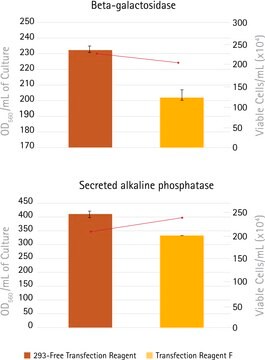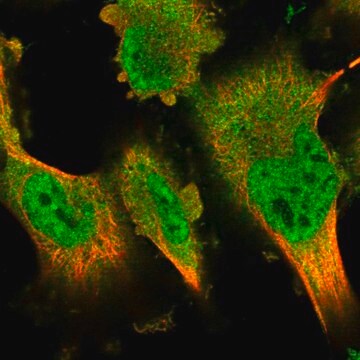XTG9-RO
Roche
X-tremeGENE™ 9 DNA Transfection Reagent
Polymer reagent for transfecting common cell lines
About This Item
Recommended Products
grade
for molecular biology
Quality Level
form
liquid (aqueous solution)
usage
mL (suitable for 165 transfections)
packaging
pkg of 0.4 mL (06365779001)
pkg of 1.0 mL (06365787001)
pkg of 5 × 1.0 mL (06365809001)
manufacturer/tradename
Roche
technique(s)
transfection: suitable
storage temp.
2-8°C
Related Categories
General description
Application
X-tremeGENE™ 9 DNA Transfection Reagent is well suited for cellular analysis applications such as:
- Expression of recombinant proteins for functional analysis.
- Physiological studies of metabolic pathways.
- Analysis of regulatory sequences using reporter gene assays.
- Gene expression assays.
- Cancer research studies.
- Target evaluation.
Features and Benefits
- Generate physiologically relevant results using a reagent with extremely low cytotoxicity for maximum post-transfection cell viability.
- Save time and eliminate multiple handling steps; simply dilute X-tremeGENE 9 DNA Transfection Reagent, incubate with plasmid DNA, and pipet the mixture directly onto your cells (with or without serum).
- Avoid time-consuming optimization procedures in commonly used cell lines.
Quality
Physical form
Other Notes
Legal Information
related product
Signal Word
Danger
Hazard Statements
Precautionary Statements
Hazard Classifications
Eye Irrit. 2 - Flam. Liq. 2
Storage Class Code
3 - Flammable liquids
WGK
WGK 1
Flash Point(F)
334.4 °F
Flash Point(C)
168 °C
Certificates of Analysis (COA)
Search for Certificates of Analysis (COA) by entering the products Lot/Batch Number. Lot and Batch Numbers can be found on a product’s label following the words ‘Lot’ or ‘Batch’.
Already Own This Product?
Find documentation for the products that you have recently purchased in the Document Library.
Customers Also Viewed
Articles
Automation is used for many applications to reduce variation caused by manual handling and to obtain reproducible results in high-throughput assays. High-throughput applications, such as knockdown studies or target screenings, often include cell transfection.
Small inhibitory RNAs (siRNAs) have become the focus of interest in many laboratories. For the first time, these molecules offer an easy way to knock down the expression of selected genes in mammalian cells without having to resort to classical gene knockout techniques.
Transfection is the introduction of DNA, RNA, or proteins into eukaryotic cells and is used in research to study and modulate gene expression. Thus, transfection techniques and protocols serve as an analytical tool that facilitates the characterization of genetic functions, protein synthesis, cell growth and development.
This brief webinar provides an overview of what transfection is and the methods that are used to introduce DNA or RNA into eukaryotic cells.
Protocols
Plate cells approx. 24 hours before transfection making sure cells are at optimal concentration (70 – 90 % confluency).
Cell preparation for transfection Plate cells approx. 24 hours before transfection making sure cells are at optimal concentration (70 – 90 % confluency).
Our team of scientists has experience in all areas of research including Life Science, Material Science, Chemical Synthesis, Chromatography, Analytical and many others.
Contact Technical Service













